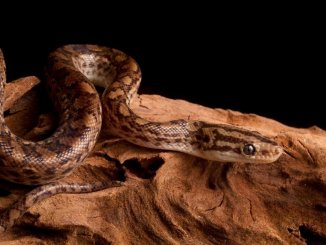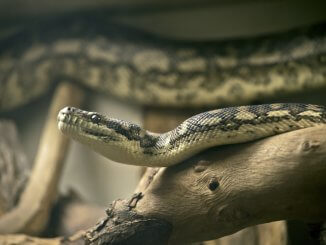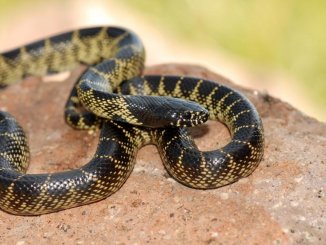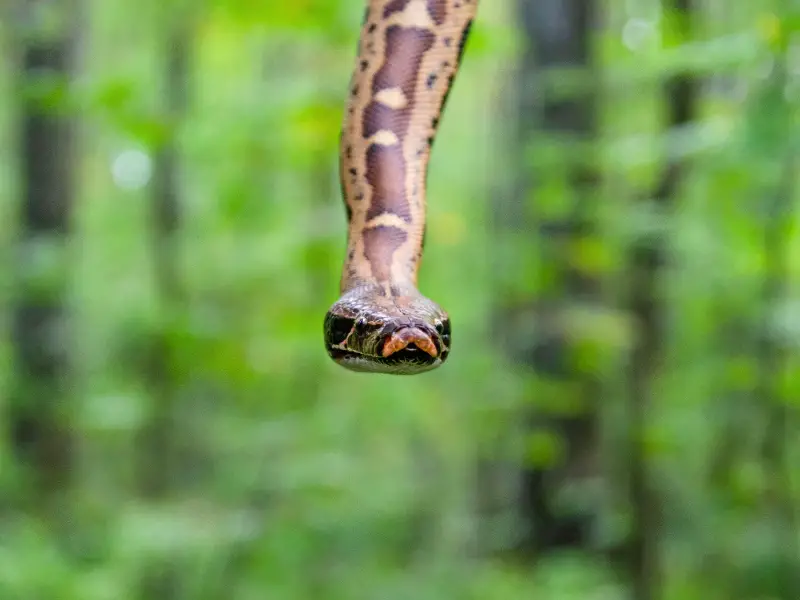
The Sumatran short-tail python is a medium-sized snake that is native to the island of Sumatra.
It is also found in the surrounding islands of Lingga, Bangka, Mentawai, and Kalimantan, as well as the Riau Archipelago.
Short-tail pythons get their name from their short tails (in relation to their strong, muscular bodies).
This snake is a true python, usually found in rainforests, marshes, and swamps.
Short-tailed pythons have become popular pet snakes in recent years.
They are not particularly difficult to care for, but due to their aggressive nature, they aren’t suitable for beginners.
Short-tail Python Overview
| Common name | Sumatran short-tail python |
| Scientific name | Python curtus |
| Natural habitat | Indonesian rainforests and swamps |
| Adult size | Approx 60 inches (but can grow up to 72 inches) |
| Average lifespan | 20 - 25 years |
| Diet | Carnivore |
| Housing | Large enclosure (minimum 48” x 24” x 24”) |
| Experience | Experienced snake handlers only |
Origin
Sumatran short-tail pythons (Python curtus) are found throughout Indonesia.
While they are most often found in rainforests and swamps, they also sometimes inhabit drier areas near rivers and streams. In the wild, they prey on small mammals and birds.
The population size is unknown, but they have been extensively harvested for exotic animal trade and the use of their skins as leather.
At last count, at least 100,000 of these pythons are collected for this purpose each year, which seriously impacts their population.
Deforestation is yet another factor that affects their natural habitat.
Appearance And Behavior
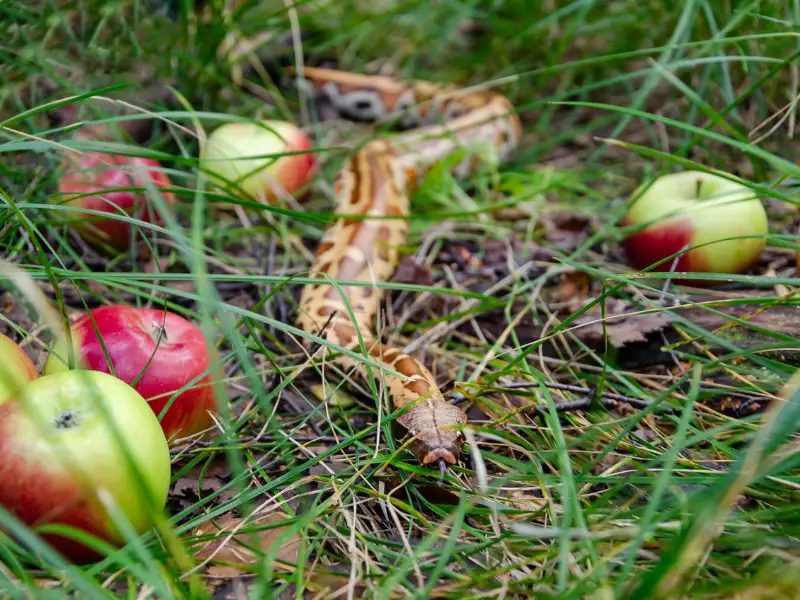
The Sumatran short-tail python is a solitary, terrestrial predator. It is nocturnal, meaning it is active at night. Like all snakes, it is a carnivore.
This short-tail python is, however, a shy and solitary creature. It only interacts with others during the mating season.
This snake has a short tapered tail, compared to its overall size, but a heavy and muscular body.
As far as snakes go, it is considered medium-sized species. It is usually grayish-brown, tan, or beige-colored with red patches.
These markings vary from brick to blood-red in color.
The males are slightly smaller than the females. If their access to a female is threatened during mating season, they will fight other males for dominance.
Fighting over food is also common, even when there is enough for all of them. But they tend to be solitary reptiles and don’t mingle with each other.
Size And Lifespan
When fully grown, this python is usually about 60 inches in length. It can, however, reach up to 72 inches.
They generally live between 20 to 25 years.
Temperament
The short-tail python is only suitable for the serious reptile owner. This snake species is known for its unpredictable and aggressive nature and is therefore not suitable for beginners.
While there are exceptions, and they can be tamed to a degree, the majority of this species are aggressive and prone to striking.
Even in the wild, this python, like all snakes, is not a very sociable animal. Many owners of this species have had to learn that the hard way, so be cautious when you handle it.
Housing A Short-Tail Python
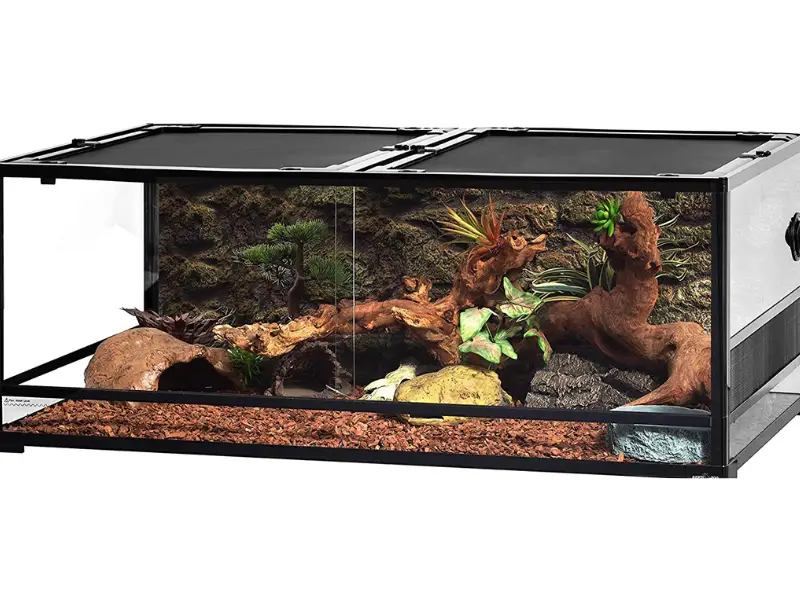
If you get your python when it is still a juvenile, you may keep it in a plastic tub at first. But you’ll need an enclosure for it as it grows.
Most short-tail python owners choose to custom-build their enclosure, with materials such as PVC.
The enclosure will need a couple of ‘hide spots’, a humidity-tolerant substrate, a few low-lying branches, a water bowl, and a basking lamp. With those in place, you won’t need much else to house your snake.
Enclosure Size
By the time your snake is an adult, you’ll need an enclosure measuring at least 48 inches x 24 inches x 24 inches. Larger specimens may need a longer enclosure, up to 60 inches.
It’s difficult to find suitable enclosures of this size and if you find one, it’ll probably be quite expensive. Therefore, it’s best to try and build your enclosure.
While you can use wood, PVC may be a better option. It will handle the humidity well without rotting like wood can.
Height is not very important as this is a terrestrial animal, but a few branches to crawl over will provide your snake with some stimulation.
Your python will sleep during the day and be active at night. So keep the enclosure in a quiet area that doesn’t get noisy during the day.
Lighting
This python needs a basking spot in its enclosure, as most reptiles do. An overhead ceramic bulb is ideal for this.
Like other reptiles, it is cold-blooded and therefore unable to regulate its body temperature. Basking solves this problem.
But unlike some other reptiles, this species does not require UVB lighting. If you have overhead lights in the enclosure, turn them off at night.
This will create an artificial day/night cycle for your short-tail python. Leaving the lights on will confuse this snake as it is nocturnal.
Temperature And Humidity
Humidity levels of about 60% to 70% are best for this species of snake.
If you don’t maintain the humidity, your snake may suffer from respiratory infections. A water bowl can help with maintaining humidity.
Coco chip substrate and cypress mulch are good choices for the enclosure floor as they retain humidity.
The temperature under the basking lamp should be approximately 88°F. Position the bulb over one side of the enclosure, so that the snake can move to the other side for a cooler spot.
The temperature at the cooler end should be about 80°F.
Generally, a heat gradient of 78°F to 83°F from the cool end to the warm end is sufficient.
Monitor the temperature and humidity with a digital thermometer and hygrometer to ensure that optimal conditions are met.
And mist the inside of the tank more often when your snake is shedding.
Substrate And Decoration
Various substrates are suitable for the short-tail python, but coco fiber is always a good option. The most important factor is that it should not get moldy easily in humid conditions.
Include a large bowl for water, as this will also help to keep the humidity high. And include at least two ‘hide spots’ for your python. A couple of low-lying branches will work great.
They don’t swim, but you should provide a shallow water bowl for soaking during shedding.
In their natural habitat, they prefer dark and cramped hiding places underneath leaf litter or low-hanging palm fronds.
Therefore, if you can recreate a couple of hiding spots like this in the enclosure, they will be the happiest. Introduce some leaves, moss, and bark as you see fit.
Create a sleeping area for your pet with some sand, small branches, and rocks, with crevices in between them. and caves where it can sleep during the day.
If you have the space, try to build an enclosure that is large enough for your short-tailed python to be able to stretch out and do a full turn.
Cleaning
You’ll definitely need a snake hook to handle your short-tail python when you want to clean the enclosure.
Putting your hand into the enclosure, especially while your snake is still getting used to you, will trigger a response.
Clean the enclosure every few weeks with a strong but non-toxic cleaner and replace the bedding or substrate materials weekly. You can spot clean daily, if necessary.
Do not be alarmed if you don’t see regular bowel movements. This species can withhold defecating for months, and in some cases even up to a year! This is normal, so you don’t have to worry.
Although it does not defecate often, it does urinate a lot. So regular cleaning is important. Exchange soaked substrate for fresh when necessary, and ensure a regular supply of clean water.
Short-Tail Python Care
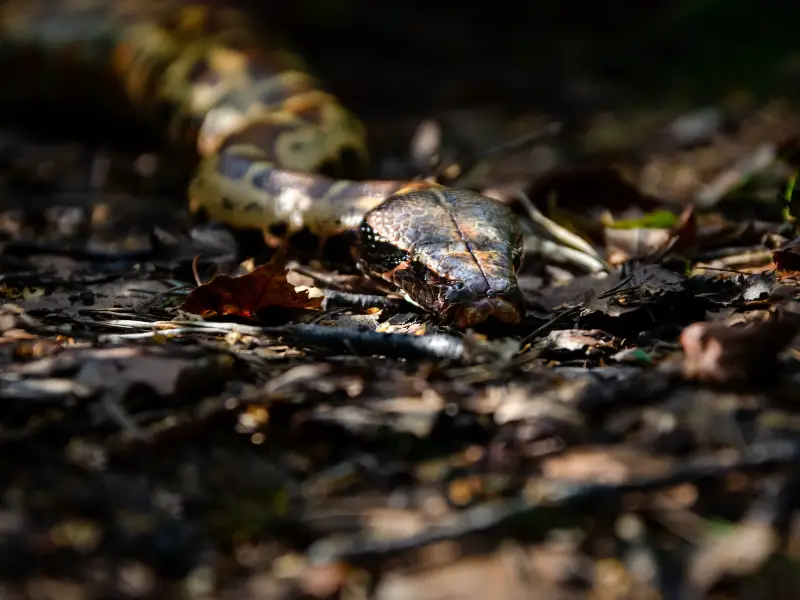
Many inexperienced owners of short-tailed pythons confuse their aggressive feeding response for hunger. It is merely an instinctual response, so don’t make this mistake.
You may get bitten, but this species is not venomous like some other deadly snakes.
Inexperienced snake handlers should rather avoid this species. But it isn’t such a difficult snake to care for if you keep the humidity just right and handle it with care.
Food And Water
When feeding juvenile pythons, you’ll need a frozen, thawed rat once a week. This rat should be slightly smaller than the girth of the snake, at its widest point.
Feed the juveniles of this species once a week until the age of one year.
Increase the size of its meal, and the time lapse between meals, as it grows. A short-tail python aged 2-4 years only needs to eat every two weeks.
And an older adult python only needs to eat a large rat every 3 weeks or so.
A very large python can have the occasional small rabbit. But your python will soon become obese if you feed it too much because it has a slow metabolism and is rather inactive.
You will know it is overweight if its usually prominent spine seems to disappear.
Short-tailed pythons need fresh water to drink and will slither around and lick water from a bowl as needed.
So place water in wide ceramic or clay bowls made of ceramic or in clay, and change it often.
Handling A Short-Tail Python
Handling a Sumatran short-tailed python is not recommended unless you are an experienced snake handler. This snake can be quite aggressive.
A snake hook is recommended for handling this species. Most of these snakes do not like being handled. And because of their weight, they are not as easy to handle as some other species.
Beware of putting your hand in the enclosure, as its aggressive feeding response will trigger this snake to strike. Short-tail pythons are easier to handle when tap-trained.
If you are determined to handle it, this is the way to go about it.
Gently tap it with a snake hook when approaching. Once it shows it’s aware of your presence, use the snake hook to move its face in the opposite direction to you.
Reach in and grab the mid-section of its body and lift it out of the enclosure.
Take note that this species won’t hold onto you as other snake species do. It will thrash around nervously if feeling insecure.
Support its entire body when handling and don’t hover over it. Your python will hiss at you to let you know when it’s uncomfortable or feeling threatened.
Your python may think someone picking him up is a threat. The bite of a python is very powerful, although non-venomous.
If bitten, clean the wound with water and soap and apply disinfectant. This is why early handling is important so that your pet learns you are not a threat.
Apart from biting, pythons also do something else when threatened; they musk. This is a strong and unpleasant smell that pythons release if feeling threatened when handled.
This usually happens in wild-caught snakes, but captive-bred snakes also musk when stressed.
Common Health Issues
- The Sumatran short-tail python is prone to respiratory infections. For this reason, it is vital that you carefully monitor the humidity levels in its enclosure and avoid stale wet conditions. A substrate that retains humidity without molding is essential. Coco chips or cypress mulch are the preferred substrate for this. A water bowl also helps to retain the humidity levels.
- Overfeeding is another problem, as this can lead to a shortened life span. Once it starts eating it cannot stop, so avoid giving it more food when it’s still eating.
- Shedding is a problem common to pythons, especially when the enclosure is not properly hydrated. The skin on the body and tail will shed easily but can cling around the eye of the eye caps and the tip of the tail if it is too dry.
But don’t stress – shedding is the sign of a healthy python. As your pet grows, it sheds its skin to be replaced by new skin. Place a bowl of water inside the enclosure, or use an automatic mister, to raise the humidity and help your python shed its skin.
If necessary, and if your python is okay with being handled, soak it in warm water once a day until the issue is resolved. Otherwise, provide a shallow vessel of water in the enclosure for it to soak itself in.
Brumation
Hibernation involves sleeping throughout the winter months, whereas a snake will brumate.
Unlike the hibernating animals who eat more before winter to store up food, as winter gets closer, a snake eats less and less.
Their digestive process is aided by warm temperatures, so as temperatures drop, they eat less food to reduce the time needed for digestion. During brumation, it may sleep for short periods. It moves around in a notably sluggish way because its metabolism has slowed down.
Even a pet python can go into brumation. Like in the wild, you’ll notice its appetite reduces and activity levels drop. To prevent a pet snake from going into brumation in cold temperatures, maintain a warm temperature in the enclosure throughout the year.
Keeping Two Or More Snakes Together
This is not a good idea. Firstly, you’d need a very large enclosure. But mainly, it’s because snakes are not social animals. Snakes should always be housed separately.
If you house two snakes together, it’ll just cause them (and you) stress. They don’t need a company in the wild, nor do they need it in captivity.
If you decide to house two snakes together, take them out of the enclosure for feeding, separately. Only bring them back once both have been fed.
This is because they still have the instincts to fight for dominance. The dominant one will eat the other one’s food.
It is also difficult to tell the sex of a snake, so you may inadvertently house two males together who will fight, Or, you may house a male and female together, who will then breed.
Breeding
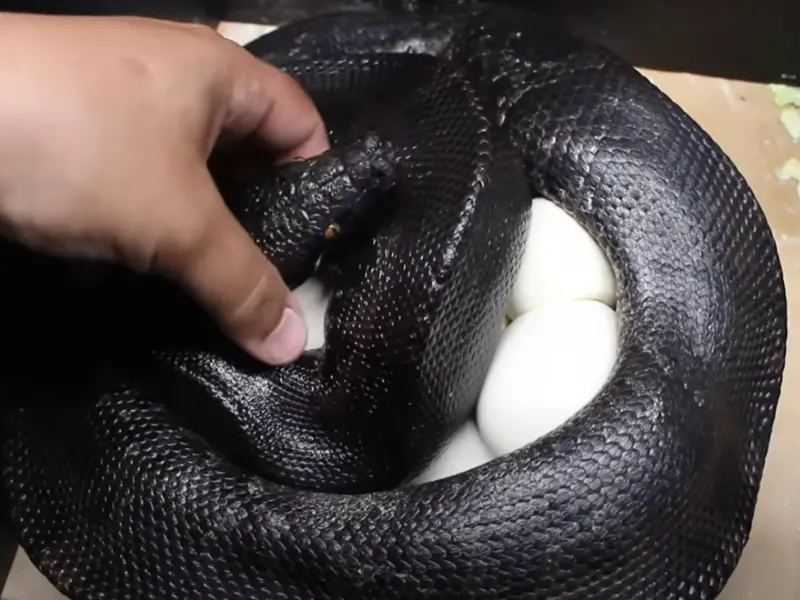
Sumatran short-tailed pythons are egg-laying snakes. Females lay up to 12 large eggs, although larger clutches have sometimes been reported.
They remain coiled around their eggs during the incubation period. In temperatures below 90°F, they may ‘shiver’ to produce heat that will warm their clutch.
After 2.5 to 3 months, the hatchlings arrive, measuring about 12 inches. They are lighter in color than adults of the species and darken with age.
Choosing And Buying A Short-Tail Python
This is an unpredictable and aggressive species of snake in the wild, but captive-bred short-tail pythons are usually more docile.
They have become quite popular in recent years, and are selectively bred to offer various colorations.
The southern black head, northern orange head, chrome head, and caramel albino are the different colors one can get.
This species usually sells for $200 online. But unless you’re experienced in dealing with pythons, and have the space for a large enclosure, rather select another reptile as a pet.
There are many beginner-friendly pet snakes to choose from, but this is not one of them.

